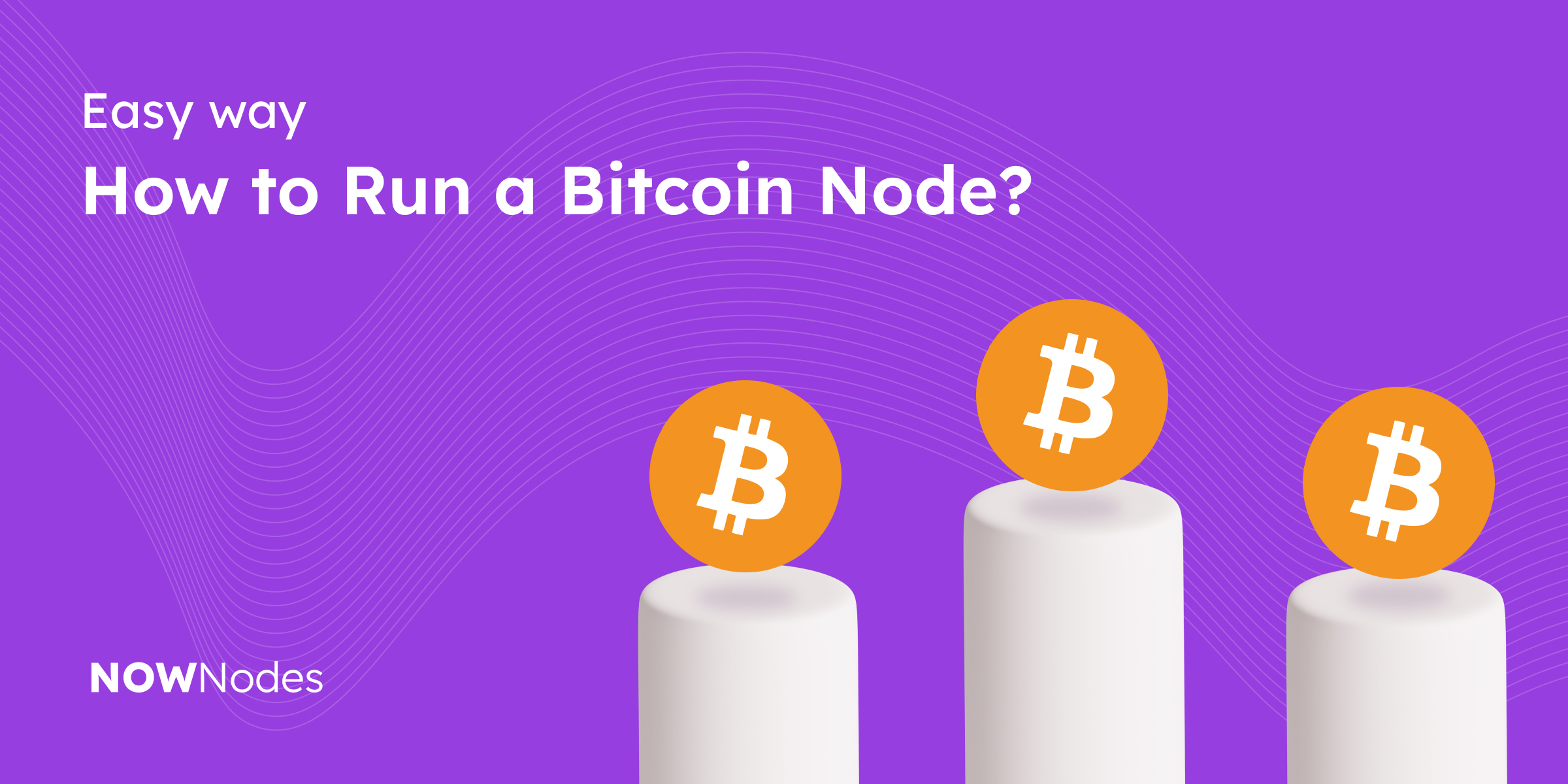Are you interested in how to run a Bitcoin node and become an active participant in the Bitcoin network? Running a BTC full node allows you to contribute to the decentralization and security of the network. In this comprehensive guide, we will show you the easiest way to run a full Bitcoin node with NOWNodes Bitcoin node API, as well as walk you through the process of setting up and running a node by yourself. Whether you are a beginner or a more experienced user, this guide will help you navigate the world of Bitcoin nodes.
Running a Bitcoin Node with NOWNodes
If you are looking for a more user-friendly and hassle-free way to run a full Bitcoin node, you might consider using NOWNodes. NOWNodes offers a range of services that simplify the process of running a node, allowing you to focus on your core objectives without worrying about technical complexities:
- Bitcoin mainnet node;
- Bitcoin testnet node;
- Mainnet WebSocket connection;
- Testnet WebSocket connection;
- Mainnet Block Explorer;
- Testnet Block Explorer.
How to get access to Bitcoin Node?
NOWNodes provides reliable and scalable infrastructure for running Bitcoin nodes, offering easy integration with your applications through their API.
- To get started with NOWNodes, simply visit the website https://nownodes.io and explore the range of available RPC nodes.
- The next step is to Sign up for your personal account by simply using your email address. The email address is the only thing you need to use the NOWNodes service.
- Then you will see all the available pricing options. You can choose the free tariff plan to access the Bitcoin mainnet and Bitcoin testnet node with ease. If you have a major project then you can choose any of the paid plans, according to your needs.
- This step only applies to free tariff plans. On the free tariff plan, you will be asked to choose 5 blockchain networks, which you are willing to use. Choose a Bitcoin network of the 100+ available blockchains.
- Then you need to navigate to the “DASHBOARD’’ in your account and scroll down the page. There you will see the button “ADD NEW KEY”. Just push the button and your API key will be ready to use.
- You can use this API key for all the available methods mentioned in NOWNodes’ official documentation.
Voila, everything is done. The only thing left is to integrate your full Bitcoin node access into your platform.
Whether you are a developer, a business, or an individual, NOWNodes Web 3 SaaS provides you with a convenient solution for running a Bitcoin node. With NOWNodes, you can quickly set up a full BTC node, ensuring 99,95% uptime, fast synchronization, and secure operation.
How to Run a Full Bitcoin Node by Yourself?
If you are interested in running a Bitcoin node by yourself, here we will walk you through all the steps on how to run a BTC full node from home.
Requirements for Running a Bitcoin Node
Before you start setting up a Bitcoin node, it’s important to ensure that you have the necessary hardware, software, and network requirements. Here are the minimum requirements for running a BTC node:
Hardware Requirements
- Desktop or Laptop: You will need a desktop or laptop computer running recent versions of Windows, Mac OS X, or Linux to run your node.
- Disk Space: Ensure that you have at least 600 gigabytes of free disk space available. The disk space should be accessible at a minimum read/write speed of 100 MB/s.
- Memory (RAM): Your computer should have at least 16 gigabytes of memory (RAM) to support the operation of the BTC node.
- Internet Connection: A broadband internet connection with upload speeds of at least 100 Mbps per second is required to connect to the Bitcoin network.
- Unmetered Connection: It is recommended to have an unmetered or high-upload limit internet connection. Running a full node on high-speed connections can consume approximately 200 gigabytes of upload bandwidth per month.
Software Requirements
To run a Bitcoin node, you will need to install the Bitcoin Core software. Bitcoin Core is the reference implementation of the Bitcoin protocol and provides the necessary tools and resources to run a full BTC node.
You can download the latest version of Bitcoin Core from the official Bitcoin website (https://bitcoin.org/en/download). Choose the appropriate version for your operating system (Windows, Mac OS X, or Linux) and follow the installation instructions provided.
Setting Up a Bitcoin Node
Now that you have the hardware and software requirements in place, let’s walk through the step-by-step process of setting up a BTC node.
Step 1: Configure Bitcoin Core
Once you have installed Bitcoin Core, you will need to configure it to suit your preferences and requirements. Here are some important settings to consider:
- Data Directory: Choose a location on your computer where Bitcoin Core will store its data. This directory will contain the blockchain, configuration files, and other important data. Make sure you have enough disk space available in the chosen directory.
- Network Configuration: Bitcoin Core supports both IPv4 and IPv6 network protocols. You can choose which protocol to use based on your internet connection and network setup.
- Connection Settings: You can configure Bitcoin Core to connect to the Bitcoin network through your internet connection. You can choose to allow incoming connections or only connect to specific nodes.
Step 2: Syncing with the Bitcoin Network
After configuring Bitcoin Core, you will need to sync it with the Bitcoin network. This process, known as the Initial Block Download (IBD), involves downloading and verifying the entire blockchain. The blockchain is a record of all Bitcoin transactions that have ever taken place.
The IBD process can take a considerable amount of time, depending on your internet connection speed and the size of the blockchain. During the IBD process, your node will not be able to see new transactions or update your wallet balance. It is important to be patient and let the synchronization process complete.
Step 3: Securing Your Node
Running a Bitcoin RPC node comes with certain security considerations. Here are some important steps to secure your node:
- Firewall: Configure your firewall to allow incoming connections only from trusted sources. This helps to protect your node from potential attacks or unauthorized access.
- Updates: Keep your Bitcoin Core software up to date with the latest security patches and bug fixes. Regularly check for hard forks and updates and install them as soon as they become available.
- Wallet Security: If you are using the built-in wallet feature of Bitcoin Core, take the necessary steps to secure your wallet. Follow best practices for password protection, back up your wallet regularly, and consider using hardware wallets for enhanced security.
Step 4: Running Your Bitcoin Node
Once your Bitcoin RPC node is fully synced with the network, you can start running it. Bitcoin Core provides a user-friendly interface that allows you to monitor the status of your node, view transaction history, and interact with the Bitcoin network. Make sure to constantly monitor the performance of your node.
Best Practices for Running a Bitcoin Node
To ensure the smooth operation of your Bitcoin RPC node and contribute effectively to the network, here are some best practices to follow:
- Stay Updated: Keep your Bitcoin Core software up to date with the latest releases to benefit from security enhancements and performance improvements.
- Maintain Sufficient Resources: Ensure that your computer has enough disk space, memory, and processing power to handle the demands of running a Bitcoin node.
- Contribute to the Network: Allow incoming connections and actively participate in the peer-to-peer network by relaying transactions and blocks to other nodes.
- Join the Bitcoin Community: Engage with the wider Bitcoin community to stay updated on the latest developments, discuss technical issues, and contribute to the growth of the network.
Conclusion
Following the steps outlined in this guide, you can set up a full Bitcoin node in less than 5 minutes or run your own Bitcoin RPC node and actively participate in the network.
Remember to ensure that you have the necessary hardware and software requirements for running a BTC node by yourself or simply use the best Bitcoin node software with NOWNodes.



